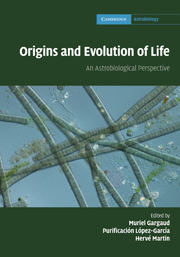Book contents
- Frontmatter
- Contents
- List of contributors
- Foreword
- Preface
- Part I What is life?
- 1 Problems raised by a definition of life
- 2 Some remarks about uses of cosmological anthropic ‘principles’
- 3 Minimal cell: the biologist's point of view
- 4 Minimal cell: the computer scientist's point of view
- 5 Origins of life: computing and simulation approaches
- Part II Astronomical and geophysical context of the emergence of life
- Part III The role of water in the emergence of life
- Part IV From non-living systems to life
- Part V Mechanisms for life evolution
- Part VI Life in extreme conditions
- Part VII Traces of life and biosignatures
- Part VIII Life elsewhere?
- Index
2 - Some remarks about uses of cosmological anthropic ‘principles’
from Part I - What is life?
Published online by Cambridge University Press: 04 February 2011
- Frontmatter
- Contents
- List of contributors
- Foreword
- Preface
- Part I What is life?
- 1 Problems raised by a definition of life
- 2 Some remarks about uses of cosmological anthropic ‘principles’
- 3 Minimal cell: the biologist's point of view
- 4 Minimal cell: the computer scientist's point of view
- 5 Origins of life: computing and simulation approaches
- Part II Astronomical and geophysical context of the emergence of life
- Part III The role of water in the emergence of life
- Part IV From non-living systems to life
- Part V Mechanisms for life evolution
- Part VI Life in extreme conditions
- Part VII Traces of life and biosignatures
- Part VIII Life elsewhere?
- Index
Summary
The aim of this contribution is to underline some problems related to what is called the cosmological anthropic principle. There are several statements (weaker or stronger) of this ‘principle’, which was initially introduced by Brandon Carter (cf. Demaret and Barbier, 1981; Barrow and Tipler, 1986; Demaret, 1991; Demaret and Lambert, 1996). Today, there are a huge number of references defining and discussing these statements and we do not want to enter such a discussion here. In fact, for our purpose, we can simply say that the ‘weak’ version expresses simply the causality principle: if human life exists in the Universe, then there exist precise constraints that render the emergence of such life possible. This can also be presented as an observational constraint. If, as human beings, we are observing the Universe now, the latter cannot be arbitrary. It has to be such that human life is possible. These ‘weak principles’ are in fact a translation of the fact that each empirical event or each phenomenon can be characterized by a set of necessary conditions. And the weak versions of what one called the anthropic principle are then nothing more than a logical implication: human life (H) implies necessary conditions for human life to exist (NCH). Or, if we are considering the observational constraint approach: the existence of human observers implies necessary constraints on the Universe that render this existence possible.
- Type
- Chapter
- Information
- Origins and Evolution of LifeAn Astrobiological Perspective, pp. 14 - 25Publisher: Cambridge University PressPrint publication year: 2011



